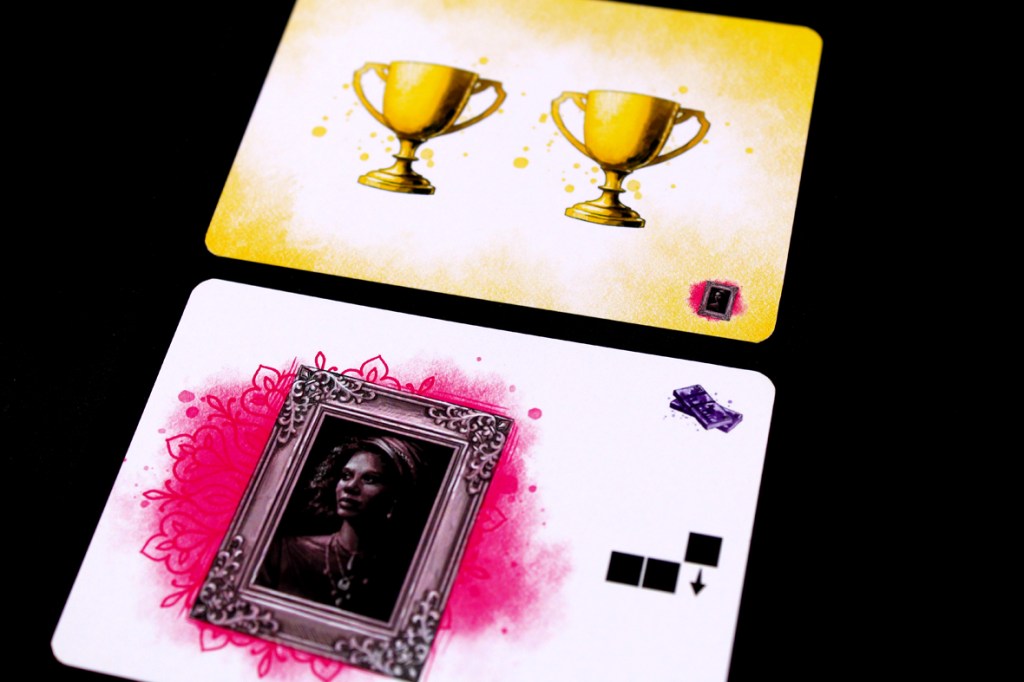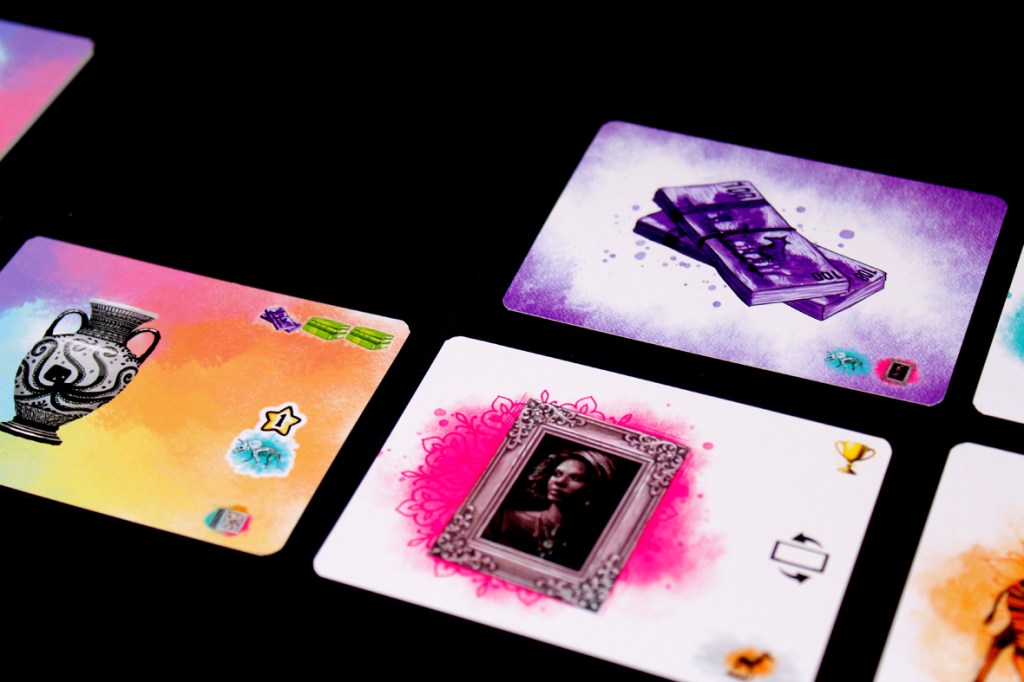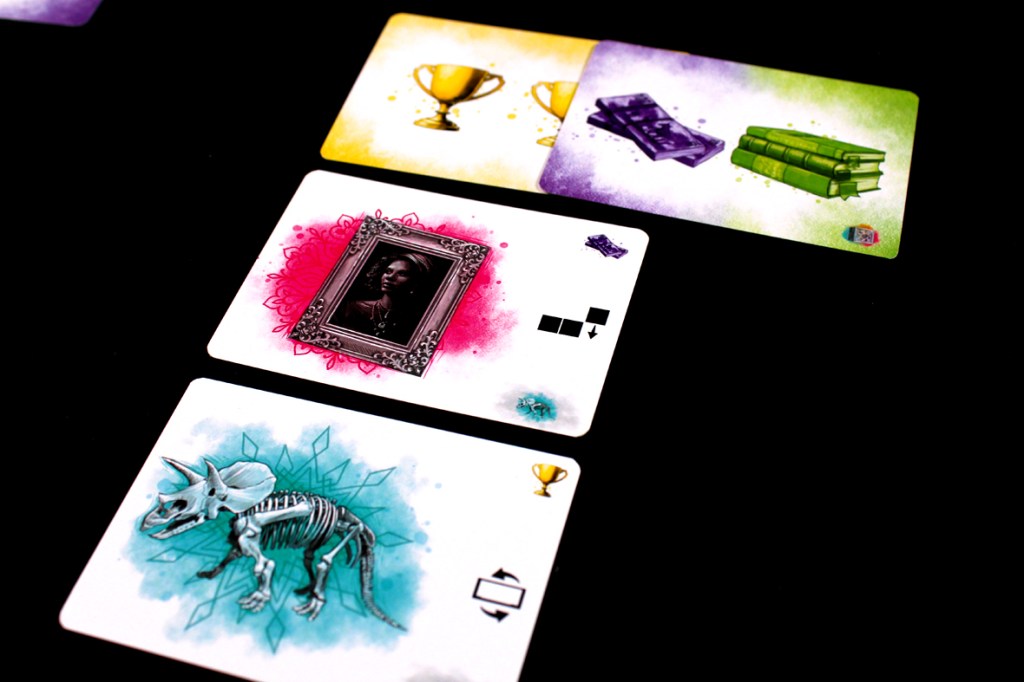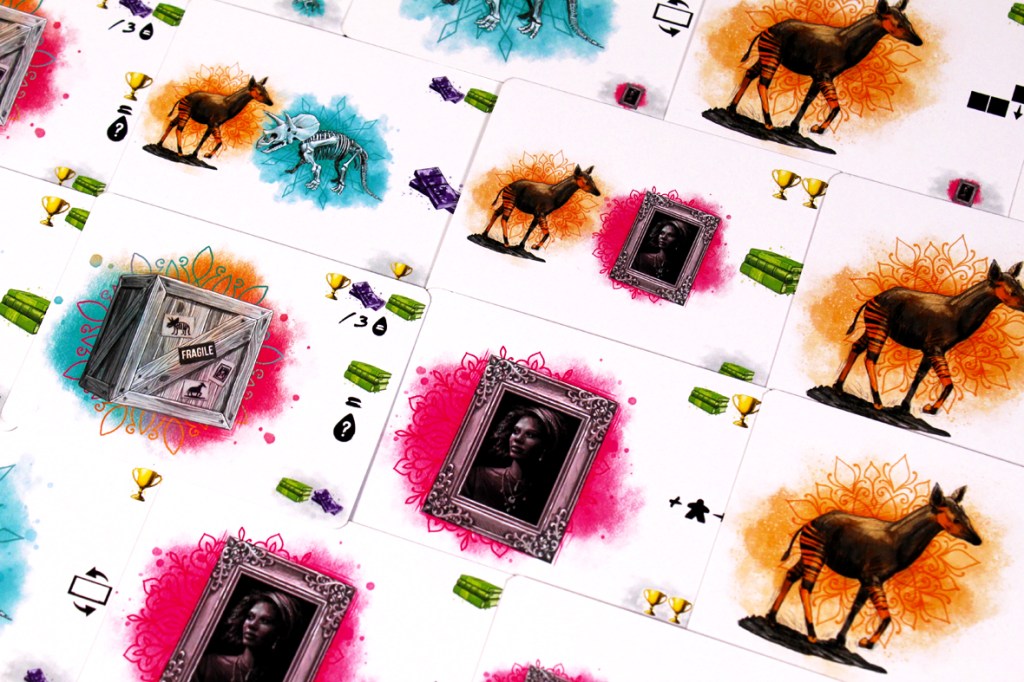
Base price: $9.
1 – 3 players.
Play time: 20 – 30 minutes.
BGG | Board Game Atlas
Check it out on Backerkit!
Logged plays: 2
Full disclosure: A preview copy of Dreams of Yesterday was provided by Weird Giraffe Games. Some art, gameplay, or other aspects of the game may change between this preview and the fulfillment of the campaign, should it fund, as this is a preview of a currently unreleased game.
At this point, crowdfunding season is as much of a state of mind as it is anything else, so there’s just an ongoing oeuvre of crowdfunding that you should expect for the foreseeable future. It’ll last through at least March, as far as I can tell. I may take a break in June for reasons as-of-yet undisclosed, but mostly just from crowdfunding stuff. More on that later. In the meantime, Weird Giraffe Games is back with another title, Dreams of Yesterday! It’s a prequel / sequel to Dreams of Tomorrow, one of their earlier titles. Let’s check it out!
In Dreams of Yesterday, players take on the roles of Curators, who believe that they can learn important things from the past in order to change the future. As a result, you need to build up a pretty impressive set of exhibits of historical objects so you can, you know, learn. You’ll need Prestige, Knowledge, and cash (mostly cash) if you want to do that, so make sure you get the right things so that you can prevent the future from getting really messy. Will you be able to create the ideal museum?
Contents
Setup
Setup isn’t too hectic. Most cards have a resource side and an Artifact side:
Shuffle the cards, and then deal each player one double resource and one single artifact. If playing with two players, remove five cards from the deck, as well. Then, remove the remaining Urn cards from the deck:

You won’t be using those yet. Now, make the Histories. That’s the main play area. It’s two rows of cards, alternating between resource and Artifact sides of cards, with the bottom-right section empty. For two players, that’s five cards (a row of three and a row of two) and for three players it’s seven cards (a row of four and a row of three).
Once you’ve set that up, you should be ready to start!

Gameplay

A game of Dreams of Yesterday is played over several turns, as players attempt to gather Artifacts to fill the exhibits of their up-and-coming museums. Let’s find out how!
On your turn, you’ll take a card from the Histories. To do so, pick a card that is one or two cards in front of the current empty space (clockwise). If it’s a resource, you can add it to your resource space. If it’s an Artifact, you can add it to one of the two Exhibit rows below your resource area! You can have two rows at a time, and new Artifacts must be placed to the left or right of an existing Artifact (left is tucked, right is placed over, covering the previous Artifact’s ability). If you don’t like the cards available, you may spend a resource per space to move an additional space. You can also spend a resource to flip a card, if you’d prefer. If you can’t buy any of the Artifacts (or don’t want to) and both spaces are Artifacts, you can draw cards from the deck until you reveal a resource card and take that.

Once your turn is over, draw a card and place it in the space that was originally empty at the start of your turn. If you took the alternate action, choose one of the two cards in front of the starting space and flip it into the starting space, so that the next player has a new place to start from.
After the deck is depleted for the first time, shuffle the Urns into the discard pile to make a new deck. Urns work like normal Artifacts, but they are always placed on the right of your Exhibits. Once an Urn is placed, you can no longer add Artifacts to the Exhibits.

The game ends as soon as the Histories cannot be refilled or if a player adds an Urn to each row of their display. If that happens, players finish the round and the game ends. Players score 1 / 3 / 6 / 10 / 15 / 21 points for 1 / 2 / 3 / 4 / 5 / 6 identical artifacts in a row. Discoveries can count as two different Artifacts if they’re between two different Artifacts (since they are wild). Add any bonus points from Urns and the player with the most points wins!
Player Count Differences

Not many! From a purely gameplay perspective, the only major player count difference is that you remove five cards from the deck randomly before you play with two players instead of three. For solo, there’s a robot player you can play against, which is nice. The major difference is with more players, the empty space on the board is going to move progressively faster than it will at two players, so you can’t quite put as much strategy into how you take cards to block other players. It makes the two-player game a bit tighter since it’s more necessarily zero-sum (you affect your opponent and they affect you), which is why I prefer the two-player game. At three, it’s more you have a player you affect and a player who affects you, and they’re not the same player, so you may want to reverse the player order or swap seats if you’re playing multiple games just to shake things up. All that said, I’m most likely to play this one at two; I appreciate the zero-sum nature of the two-player game.
Strategy

- Don’t just take resources to take resources; have a plan in mind. Taking resources is great and all, but hoarding them both hastens the end of the game and doesn’t really get you much if you have nothing you can spend them on. Take a look at which Artifacts might be in your purview after your current turn, and focus on trying to get the resources you need so that you can buy them as part of a larger strategy. You don’t just want to take Artifacts at random, either.
- Keep in mind that the card you take determines where your opponent starts their next turn, so you might be able to take strategically to limit their options. Take a look at what resources your opponent has; you might be able to use that information as well. If you see they don’t have enough resources to buy an Artifact, you might be able to place them such that they can’t do anything on this turn and will have to draw from the deck instead, which might be a useful waste of their time. There’s a lot of information available on that front.
- Choose which side of the card to place up to either benefit yourself or block something your opponent needs. Is the top card an Artifact that would really help your opponent, should they get it? Put it resource-side up! Just keep in mind that one card ability lets you flip cards, so you might end up not really doing anything of consequence.
- The abilities can give you a lot of utility! They have a lot of pretty useful abilities, if you can get them to work for you. You can rearrange Exhibits, buy cards farther away, move extra spaces, get a free resource, or use resources as a wild, for instance. Just remember that you can only use the ability on your rightmost Artifact in each row, so plan accordingly.
- Trying to create big chains of the same Artifact is pretty valuable, but eventually your opponents will find it prudent to block you from doing that. The game gives you more points for each Artifact of the same type when you’re creating sets, so having more of one type of Artifact is pretty explicitly better. That said, if you make moves to try and buy all the Artifacts of one type, your opponents are going to start buying them as well, both because they’re still points and also it becomes worth it to them to stymie your attempts to get a ton of points.
- Try to get at least one wild; that can really be useful when you’re creating sets. It’s useful because it’s a freebie and also, a wild can count as more than one set if it’s the bridge between two different Artifact types, which is a fun little bonus. So that can get you some free points if you play your cards right.
- Urns also can be pretty useful, provided they align with what you’re already planning. Don’t just get Urns to get Urns; they block your Exhibit row and make it so you can’t play anything else to that row, which can be pretty wasteful. If the bonus they give is aligned with what you’re already doing, great! If not, look elsewhere.
Pros, Mehs, and Cons

Pros
- Very pleasant art! Beth’s art, as usual, really shines here. I particularly like the work done on the Urns and the Discoveries; Beth’s color blending work is pretty excellent, and it does a great job of representing that the Discoveries are wild. Clear visual language is always a plus. The Urns just look great.
- I also appreciate the alliterative titles of the various artifacts; it’s fun to say. Generally, alliteration is pleasant.
- The game is pretty easy to set up, which I always appreciate. You just shuffle the cards, deal a few to each player, and then set up the Histories section in the middle. It’s relatively light, which is probably where it should be, as a microgame. You don’t really want to err on the side of complexity with these sorts of things.
- Very portable, too; love seeing more microgames hitting. The case is a bit of a pain to put the cards away in (the hazards of preview copies; I assume this will be fixed for the full release), but generally it’s the kind of game you can slide in a pocket without much trouble. It’s 27 cards, after all. I’m always happy to see more microgames popping up. It’s a great genre of games to have and
- I find games with clockwise motion weirdly soothing. I’m not sure what it is about the games, but I tend to remember them and I like that feature of gameplay a lot? I think my favorite example remains Sol: Last Days of a Star, but the others have been pretty good, as well. Here, it’s just a nice feature of playing a quick game as you take cards in a slow circle. Not really sure it integrates with the gameplay or theme in any meaningful way, but I still find it pleasant.
- The single / double resource cards provide an interesting tension to when and how you choose to spend resources. It definitely makes me less likely to spend a double resource card to move only one space, for instance, but
- I also appreciate that the card you take provides the starting spot for the subsequent player. It’s a nice way to control / constrain player movement, and allows you to make some strategic decisions. I particularly like it as a handy decision tiebreaker if two things are equally good for you: which option gives your opponent the worse position on their next turn? Then, do that.
Mehs
- The money being purple and the books being green causes me a bit of US American Confusion, but I wonder if that’s the same for other folks. I think the stacks don’t help either; it just strikes me as an odd choice. In my brain, money is always green, so Stacks of Green Object is almost always “money”, and then I don’t have the same association with whatever the purple stuff is. I imagine it was done to shake things up a bit, but it still seems … confusing. I’d be curious to see if folks who don’t have the same association have the same problem.
- When drawing a resource from the deck (as part of the alternate action) it’s a bit unclear as to whether or not you’re supposed to flip the cards when shuffling or just shuffle the deck normally. I think this is just a rules whoopsie, but for the Alternate Action, you go through the deck until you encounter a resource card. If the deck hasn’t been shuffled yet, do you flip the cards around when you shuffle? Are cards always resource-side up in the deck? It’s unclear.
Cons
- I think the card abilities add a bit more complexity than the microgame needs. It’s an odd thing; it adds one more extra step of processing and tracking that otherwise wouldn’t be there, and I’m not sure the gains from being able to buy anything for an extra resource, rearrange your exhibits, or use resources as wilds is really giving as much as it’s asking for in return. It feels like the game might be a bit tighter and faster without it, leaning more into the “micro” of the microgame. With the abilities, there’s a bit more cognitive load put onto the players, and even then, I don’t see a lot of the abilities getting used during play.
Overall: 6.5 / 10

Overall, I enjoyed my plays of Dreams of Yesterday! As I’ve said elsewhere, I think the microgame space is booming right now, so it’s always nice to see more games with a small footprint pop up. The constraint of a microgame forces some interesting design choices, and you get to see a lot more utility from individual components (since they often have to do two or three unique things with their limited components). Here, you get that and you also get one of my absolute favorite mechanics, which is just the gently-soothing circular motion of going around and drafting cards to either use as resources or collect as Artifacts. I’ll be real: I don’t really get the thematic link between this and Dreams of Tomorrow, but, that’s not always a huge deal. If this was the first game whose thematic connection didn’t quite land for me, that would be one thing, but it’s not. Where I do get a bit stuck with Dreams of Yesterday is that I feel like it’s almost a bit overloaded for a microgame, in terms of just general gameplay flow. The abilities of the cards were a particular sticking point, since they didn’t see a ton of use in our games but required additional checks to fully understand, as my group tends to struggle with icons on our first playthroughs. The ability icons end up making the cards a bit busier, and especially for Artifacts, where they already need to show the resource cost, the card on the other side, and the ability symbol, you’re starting to overload the card from an information presentation standpoint. Not a dealbreaker, certainly, but a challenge that we ran into during gameplay. The money being purple and the books being green was an odd choice, but hey, I’m not necessarily the one to quibble aesthetics. It’s a quick enough little game, the set collection is pretty fun, and Beth Sobel art really does always do wonders for a title. If you’re looking to try out microgames, you’re a fan of set collection, or you want more games with okapis in them, you might enjoy Dreams of Yesterday!
If you enjoyed this review and would like to support What’s Eric Playing? in the future, please check out my Patreon. Thanks for reading!

